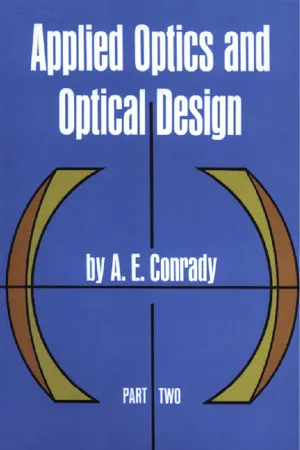
- 352 pages
- English
- ePUB (mobile friendly)
- Available on iOS & Android
Applied Optics and Optical Design, Part Two
About This Book
"For the optical engineer it is an indispensable work." — Journal, Optical Society of America
"As a practical guide this book has no rival." — Transactions, Optical Society
"A noteworthy contribution, " — Nature (London)
This two-volume paperback republication of A. E. Conrady's classic work presents his complete system of optical design. The only work of its kind in English, this set leads the reader step by step from the fundamental concepts of geometrical and physical optics up to the point where he can design the simpler optical systems without aid. It remains the only detailed work on the subject written with the needs of the practical designer and the self-taught constantly in mind. For most of the text, no mathematics above trigonometry is needed; occasional sections require some calculus and analytical geometry.
Part I covers all ordinary ray-tracing methods, together with the complete theory of primary aberrations and as much of higher aberration as is needed for the design of telescopes, low-power microscopes and simple optical systems. Chapters: Fundamental Equations, Spherical Aberration, Physical Aspect of Optical Images, Chromatic Aberration, Design of Achromatic Object-Glasses, Extra-Axial Image Points, The Optical Sine Theorem, Trigonometric Tracing of Oblique Pencils, General Theory of Perfect Optical Systems, and Ordinary Eyepieces.
Part II extends the coverage to the systematic study and design of practically all types of optical systems, with special attention to high-power microscope objectives and anastigmatic photographic objectives. Edited and completed from the author's manuscript by Rudolf Kingslake, Director of Optical Design, Eastman Kodak Company. Chapters: Additional Solutions by the Thin-Lens Method, Optical Path Differences, Optical Path Differences at an Axial Image Point, Optical Tolerances, Chromatic Aberration as an Optical Path Difference, The Matching Principle and the Design of Microscope Objectives, Primary Aberrations of Oblique Pencils, Analytical Solutions for Simple Systems with Remote Stop, Symmetrical Photographic Objectives, and Unsymmetrical Photographic Objectives.
Frequently asked questions
Information
CHAPTER XI
ADDITIONAL SOLUTIONS BY THE THIN-LENS METHOD







Table of contents
- Cover
- Title Page
- Copyright Page
- Dedication
- Foreword
- Editor
- Contents
- XI. Additional Solutions by the Thin-Lens Method
- XII. Optical Path Differences
- XIII. Optical Path Differences at an Axial Image Point
- XIV. Optical Tolerances
- XV. Chromatic Aberration as an Optical Path Difference
- XVI. The Matching Principle and the Design of Microscope Objectives
- XVII. Primary Aberrations of Oblique Pencils
- XVIII. Analytical Solutions for Simple Systems With Remote Stop
- XIX. Symmetrical Photographic Objectives
- XX. Unsymmetrical Photographic Objectives
- Appendices
- Index